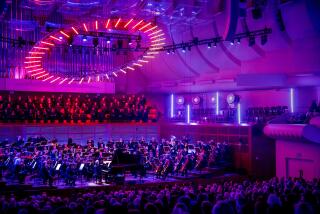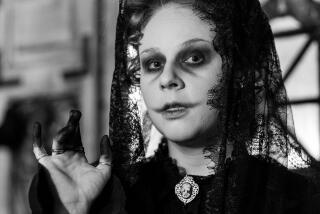Giving voice to the ‘Exquisite Corpse’
Sabotaging rational, waking logic was one of the Surrealists’ primary ideas of fun. By shuffling recognizable conventions rather than abandoning or abstracting them, they worked both angles of the familiarity reflex. Such is the scheme behind the Surrealist parlor game known as exquisite corpse, in which one artist draws a body part unseen by others in a collective art project. The result is a composite portrait with plenty of chance in the mix.
In Saturday’s musical adaptation, part of the experimental “sound” series at the Schindler House in West Hollywood, the game pieces involved musicians and architecture and X factors arising from the spatial interaction of the two. Historical connections also hummed beneath the surface, given that the Modernist Schindler House design dates from 1922 and that Andre Breton’s Surrealist manifesto was issued in 1924. Both Modernists and Surrealists sought to upend an existing cultural order but with different means.
Devotees of both schools might well have appreciated this project, although the mostly improvisational language drawn on by these six Los Angeles-based musicians would have been alien then. For this real-time “Exquisite Corpse,” musicians were dispersed around the house, facing the backyard-centered audience, celebrating the house’s indoor-outdoor spirit. Sonic segues led from one musician’s solo segment to the next, with duet encounters lining the progression. Kris Tiner’s opening trumpet sounds, in craggy textures and sparse, cracked phrases, made the quasi-clarion call from a corner of the yard. Drummer Joseph Berardi, in the living room across the lawn, played off Tiner’s syncopations. Berardi’s solo ended with drum-triggered vocal samples leading naturally into vocalist Weba Garretson’s solo, combining extended and electronics-enhanced sounds with a dramatic thread concerning domestic abuse and the unsettling stuff of dreams.
Mitchell Brown’s intriguing blend of real and electronic sounds opened with bowed cables, producing a gravelly voice-like sound similar to Hans Reichl’s daxophone, flowing into Petra Haden’s voice and violin segment. Haden’s enchanting section was the show’s most melody-driven, weaving through twisted folk song phrases and briefly quoting the kitschy five-note chant of the “Close Encounters” theme, a surreal touch given the evening’s decidedly non-Hollywood flavor.
Guitarist G.E. Stinson’s wild and emotionally cool variations on the theme of electric guitar vocabulary ended in softly brushed chords over which Tiner returned to tie up the performance in a lyrical cloud of a duet. The effect was a mutant musical portrait, flattering both the magical host setting and this loose coalition of local experimentalists.
More to Read
The biggest entertainment stories
Get our big stories about Hollywood, film, television, music, arts, culture and more right in your inbox as soon as they publish.
You may occasionally receive promotional content from the Los Angeles Times.










